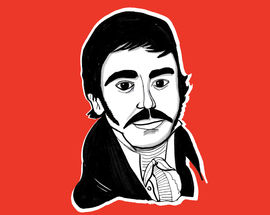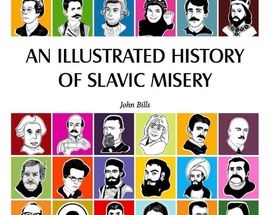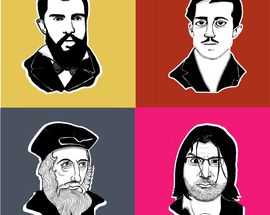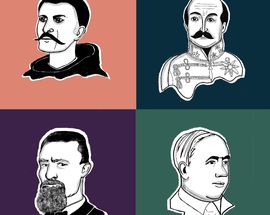Say It as You Read It
Here we go with the dinars again! Serbian money is quite interesting to the outsider. Well, I guess all foreign money always will be, especially that weird plastic stuff that Australia has, but Serbian money is fun mostly because of the people you find on the notes themselves. The 100 dinar note, with Nikola Tesla thoughtfully staring out in that iconic pose you always see him in, is the one most people talk about, but I’ve always had a soft spot for the 10 dinar note myself. The handsome fellow on the 10 dinar note is a young Vuk Karadžić, a name that will illicit vacant stares from anyone with no interest in Serbia and its linguistic history. If you’ve no interest in Serbia’s linguistic history, prepare to have your interest piqued.Born near Loznica in western Serbia, 1787, Vuk Karadžić would grow up to become the father of the study of Serbian folklore. His story is a gripping one from the get-go, from the moment he made his debut on the planet back in the late 18th century. The Karadžić family had thus far had a particularly low infant survival rate, so this kid was named ‘Vuk’ (Serbian for ‘wolf’) in an attempt to ward off any witches or whatever would come to get him. This was fairly common practice back in t’day, and whilst more often than not it ended with a dead wolf, this particular baby Vuk lived on to howl another day. His luck continued, as it turns out he was related to the only literate person in the entire region, who in turn taught him to read and to write. He spent a lot of his early time at a monastery called Tronaša, and it is at this point that I’m reminded that monastery is a strangely hard word to type. Vuk’s education would prove to be one of many false starts, but he eventually became one of the first students at Belgrade Higher School. The luck of the wolf would not end there.
Being an able-bodied bloke from Šumadija, Vuk was inevitably going to take part in the Serbian Uprising of 1804 (led by Karađorđe, remember), and he didn’t let us down here by serving as a scribe. When that uprising went to soup Vuk upped sticks and left for Vienna, where he almost immediately began working for the Serbian press. Some of that good old fashioned wolf luck kicked in again, as there was a strong demand in Central Europe for a Serbian scholar at the time, mostly down to the fact that intellectuals deeper in the continent were all about embracing the speech of ordinary folk. The development of literary languages was going to be one of the major fads of the 19th century.
A Slovenian linguist by the name of Jernej Kopitar was working in Vienna at the time, and he had already completed a large amount of work for the outline of what would become modern Serbian. What he needed was a Serbian to come along and put in the hard yards, put in the groundwork to complete the task. As a result, Jernej Kopitar and Vuk Karadžić fast became friends. Karadžić would prove to be just what Jernej was looking for.
At this point, the Serbian written language was based on the liturgical language of the Serbian Orthodox Church, a script known as Slaveno-Serbian. This was completely understandable, as the church was the only decent-sized institution to survive the many Ottoman invasions and occupations and as a result was the only one to preserve high cultural ties with those glorious Serbian Kingdoms of years gone by. The main problem with the language was that it was archaic as balls, and took many features from Old Bulgarian and Russian. The only folk who used it were those heavily involved in the church, with the vast majority of Serbs speaking something rather different. They wrote as they spoke, read as they wrote. Think of it as text message language but less soul-destroying.
Being a chap brought up in the peasantry, Karadžić had been exposed to the poetry and songs of the Serbian people from a young age. He began to collect these songs in an attempt to put them to paper, to take the vast cultural reservoir of traditional songs, imagery and themes and found a regularised literary language in the process. The conservatives of Serbia were understandably miffed by all of this, but the momentum of the peasants proved too strong.
Karadžić published his two volumes of songs in 1815 (he eventually published nine), the first of which consisted of mostly lyric songs (which he referred to as ‘women’s songs’) and the second was full of stirring heroic songs. It was at this time that the importance of the Battle of Kosovo began to scrap its way to the fore, with Karadžić frequently comparing Miloš Obilić (the man thought to have jammed a knife through the heart of the Ottoman leader of that invasive battle) to Achilles. On the whole Kosovo took a fairly minor role in his collection, but from this point on it would be latched onto with greater frequency.
As a result, Vuk Karadžić became the founder of modern Serbian literary consciousness. His work became essentially the voice of the national spirit, inadvertently creating a powerful symbol of potential Yugoslav unity. Rousing peasant songs weren’t exclusive to the Serbs of course, and Karadžić’s collection contained songs from Dalmatia, Bosnia, Herzegovina, Montenegro and Slavonia. Epic poetry was a shared property of the South Slavs, but Vuk was a man of his time. To him, you were a Serb if you spoke like one. He may have created the basis for contemporary Yugoslav literature, but Vuk Karadžić didn’t give a hoot about such things. He was doing what he considered to be purely Serbian work.
Along with his volumes of epics, Vuk Karadžić published the first Serbian grammar, a dictionary, and in 1847 a translation of the new testament. That man Kopitar did a lot of PR work, making the intellectuals of Austrian and German society aware of Vuk’s forays into the art of Serbia’s simple folk. Karadžić continued collecting songs well into the 1830s, at which point he went to Kotor (Montenegro) to recover from a bout of illness and subsequently met another Vuk, Vuk Vrčević, who went on to be one of his most loyal collaborators.
At this time however Karadžić’s work was banned throughout Serbia, at the decision of its ruler, Miloš Obrenović. There were many reasons for this, the main one being that it was a time of uneasy peace between Obrenović and the Ottomans, and it was felt that Karadžić’s work was potentially politically hazardous. Serbs had been under Turkish rule for a fair whack by this point, and despite the failure of Karadjordje’s uprising, the scent of independence had been crammed deep into the Serbian nose. Probably fairly, ol’ Miloš thought that the inspirational olde-timer songs that Karadžić was publishing would stir up further national pride, and the recently ended (second) Serbian Uprising against the Turks would be revisited with terrible consequences. Out of that uprising Serbia had won an uneasy autonomy, one that couldn’t be risked.
Even so, Karadžić was reforming the Serbian language whether Miloš liked it or not. He established that Serbian has 30 distinct sounds, and six of these had no Cyrillic letter equivalent. He introduced new letters and discarded some of the obsolete ones. He made a concise effort to distance modern Serbian from Slaveno-Serbian and to bring it closer to common folk speech. In his reformation of the language, Vuk Karadžić made the official language from the words of the people.
Despite his influence and not infrequent luck Vuk lived in poverty throughout the majority of his life. His work was viciously opposed by the Church and by many other writers, due to its almost heretical nature. Abandoned by the ruling Serbs of the time, Karadžić was nonetheless honoured across Europe and decorated by the monarchs of both Russia and Austria-Hungary. He was particularly popular in the former, and it was the Tsar of Russia who granted our Vuk his pension in 1826. Despite their opposition, his modern Serbian language was adopted by the government in 1868, four years after his death. He died in Vienna at the age of 76. How he managed to get to that age is a mystery to me, as his life was plagued with illness and injury. He had a wooden leg for much of his life, due to complications when young and a refusal to amputate the thing. 76! Not bad.
Just a reminder: the preceding was an excerpt from the book, An Illustrated History of Slavic Misery: The good and the great of Slavic history, dusted off and celebrated, which you can read more about here and here, and buy online here.









Comments